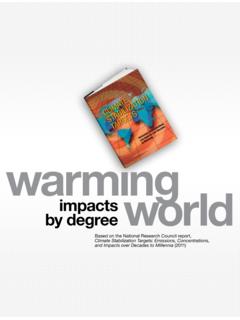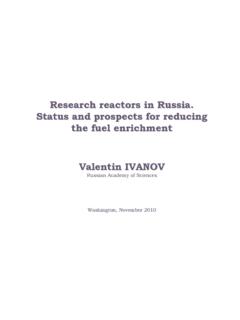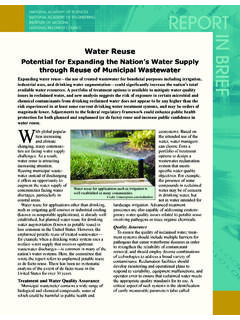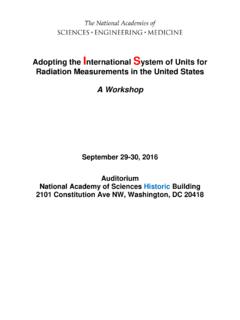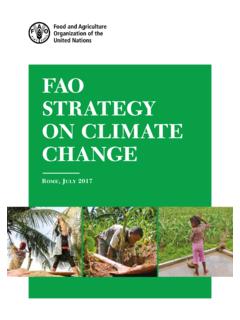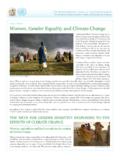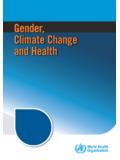Transcription of Climate Change Evidence & Causes - dels.nas.edu
1 An overview from the Royal Society and the US National Academy of SciencesClimate Change Evidence & Causes2 Climate Changen summary It is now more certain than ever, based on many lines of Evidence , that humans are changing Earth s Climate . The atmosphere and oceans have warmed, accompanied by sea-level rise, a strong decline in Arctic sea ice, and other Climate -related Evidence is clear. However, due to the nature of science, not every single detail is ever totally settled or completely certain. Nor has every pertinent question yet been answered. Scientific Evidence continues to be gathered around the world, and assumptions and findings about Climate Change are continually analysed and tested.
2 Some areas of active debate and ongoing research include the link between ocean heat content and the rate of warming, estimates of how much warming to expect in the future, and the connections between Climate Change and extreme weather events. The Royal Society and the US National Academy of Sciences, with their similar missions to promote the use of science to benefit society and to inform critical policy debates, offer this new publication as a key reference document for decision makers, policy makers, educators, and other individuals seeking authoritative answers about the current state of Climate - Change science. The publication makes clear what is well established, where consensus is growing, and where there is still uncertainty.
3 It is written and reviewed by a UK-US team of leading Climate scientists. It echoes and builds upon the long history of Climate -related work from both national science academies, as well as the newest Climate - Change assessment from the United Nations Intergovernmental Panel on Climate information is a vital component of the Evidence required for societies to make sensible policy decisions. Climate - Change science will continue to help society make informed decisions about how to reduce the magnitude of Climate Change and to adapt to its impacts. The Royal Society and the US National Academy of Sciences will continue to support the use of robust science toward these critical 2008 Raymond and Beverly Sackler established the USA-UK Scientific Forum to help the scientists of the United Kingdom and the United States forge an enduring partnership on topics of worldwide scientific concern.
4 As Presidents of the Royal Society and National Academy of Sciences, we are pleased to introduce the latest piece of work supported by the Sacklers inspired Ralph J. Cicerone President, National Academy of SciencesSir Paul Nurse President, Royal SocietyForewordSumm ary .. 2 Climate Change Q& A1 Is the Climate warming? .. 32 How do scientists know that recent Climate Change is largely caused by human activities? .. 53 CO2 is already in the atmosphere naturally, so why are emissions from human activity significant? .. 64 What role has the Sun played in Climate Change in recent decades? .. 75 What do changes in the vertical structure of atmospheric temperature from the surface up to the stratosphere tell us about the Causes of recent Climate Change ?
5 86 Climate is always changing. Why is Climate Change of concern now? .. 97 Is the current level of atmospheric CO2 concentration unprecedented in Earth s history? .. 98 Is there a point at which adding more CO2 will not cause further warming? .. 109 Does the rate of warming vary from one decade to another? .. 1110 Does the recent slowdown of warming mean that Climate Change is no longer happening? .. 1211 If the world is warming, why are some winters and summers still very cold? .. 1312 Why is Arctic sea ice decreasing while Antarctic sea ice is not? .. 1413 How does Climate Change affect the strength and frequency of floods, droughts, hurricanes, and tornadoes?
6 1514 How fast is sea level rising? .. 1615 What is ocean acidification and why does it matter? .. 1716 How confident are scientists that Earth will warm further over the coming century? .. 1817 Are Climate changes of a few degrees a cause for concern? .. 1918 What are scientists doing to address key uncertainties in our understanding of the Climate system? .. 1919 Are disaster scenarios about tipping points like turning off the Gulf Stream and release of methane from the Arctic a cause for concern? .. 2120 If emissions of greenhouse gases were stopped, would the Climate return to the conditions of 200 years ago? .. 22 The Basics of Climate Change .. B1 B8 Conclusion.
7 23 Acknowledgements .. 24 For Further Reading .. C3contents1 Evidence & Causes 2 Climate ChangeGREENHOUSE GASES such as carbon dioxide (CO2) absorb heat (infrared radiation) emitted from Earth s surface. Increases in the atmospheric concentrations of these gases cause Earth to warm by trapping more of this heat. Human activities especially the burning of fossil fuels since the start of the Industrial Revolution have increased atmospheric CO2 concentrations by about 40%, with more than half the increase occurring since 1970. Since 1900, the global average surface temperature has increased by about C ( F). This has been accompanied by warming of the ocean, a rise in sea level, a strong decline in Arctic sea ice, and many other associated Climate effects.
8 Much of this warming has occurred in the last four decades. Detailed analyses have shown that the warming during this period is mainly a result of the increased concentrations of CO2 and other greenhouse gases. Continued emissions of these gases will cause further Climate Change , including substantial increases in global average surface temperature and important changes in regional Climate . The magnitude and timing of these changes will depend on many factors, and slowdowns and accelerations in warming lasting a decade or more will continue to occur. However, long-term Climate Change over many decades will depend mainly on the total amount of CO2 and other greenhouse gases emitted as a result of human & Causes Is the Climate warming?
9 Yes. Earth s average surface air temperature has increased by about C ( F) since 1900, with much of this increase taking place since the mid-1970s (figure 1a). A wide range of other observations (such as reduced Arctic sea ice extent and increased ocean heat content) and indications from the natural world (such as poleward shifts of temperature-sensitive species of fish, mammals, insects, etc.) together provide incontrovertible Evidence of planetary-scale warming. The clearest Evidence for surface warming comes from widespread thermometer records. In some places, these records extend back to the late 19th century. Today, temperatures are monitored at many thousands of locations, over both the land and ocean surface.
10 Indirect estimates of temperature Change from such sources as tree rings and ice cores help to place recent temperature changes in the context of the past. In terms of the average surface temperature of Earth, these indirect estimates show that 1983 to 2012 was probably the warmest 30-year period in more than 800 years. A wide range of other observations provides a more comprehensive picture of warming throughout the Climate system. For example, the lower atmosphere and the upper layers of the ocean have also warmed, snow and ice cover are decreasing in the Northern Hemisphere, the Greenland ice sheet is shrinking, and sea level is rising [Figur e 1b]. These measurements are made with a variety of monitoring systems, which gives added confidence in the reality that Earth s Climate is A1 Figure 1a.
